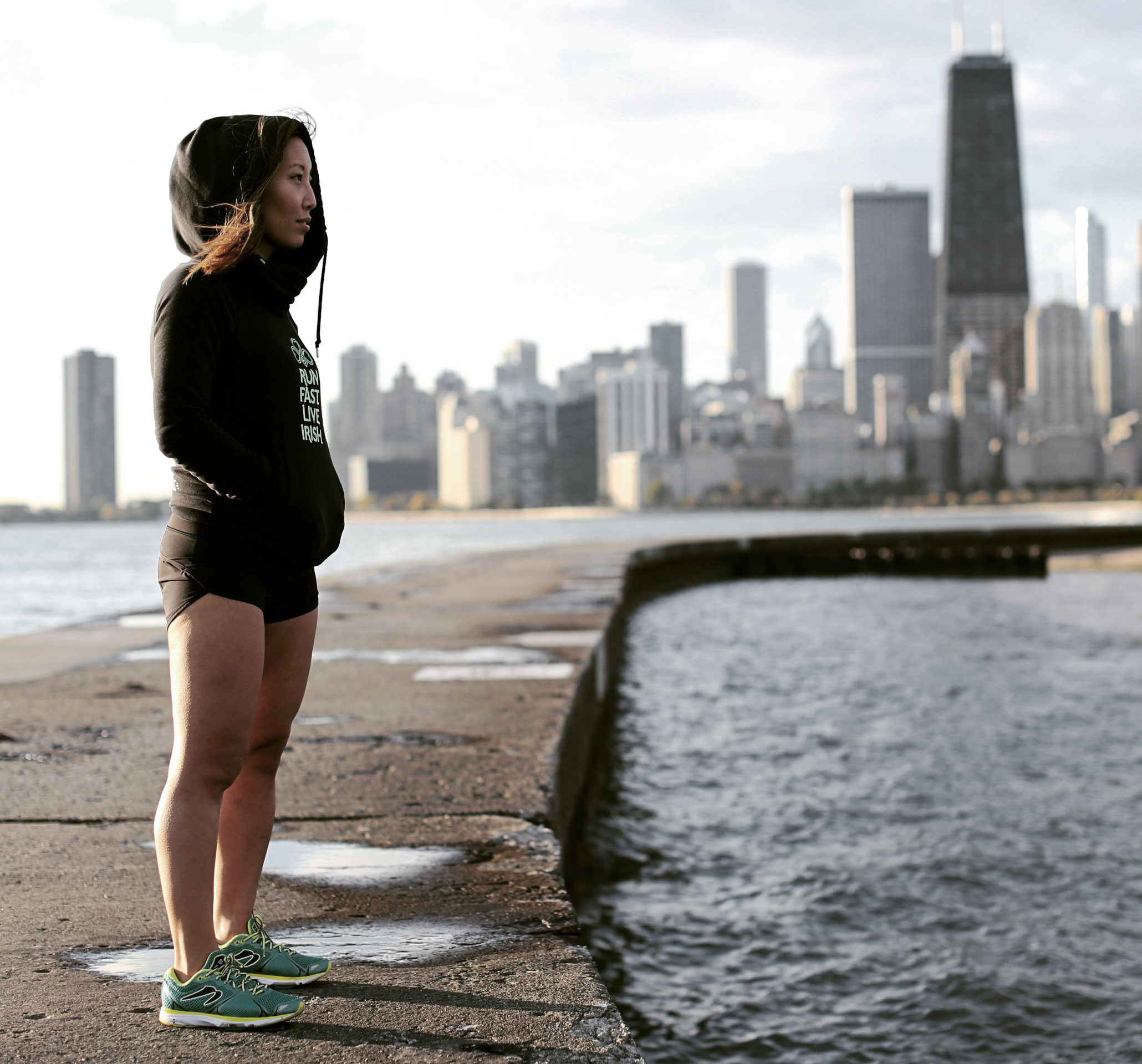

Read Ep. 15 | Show Notes
I’m giving away a copy of Dr. Sheil Shukla’s exceptional new book, Plant-Based India!
Enter below for your chance to win!
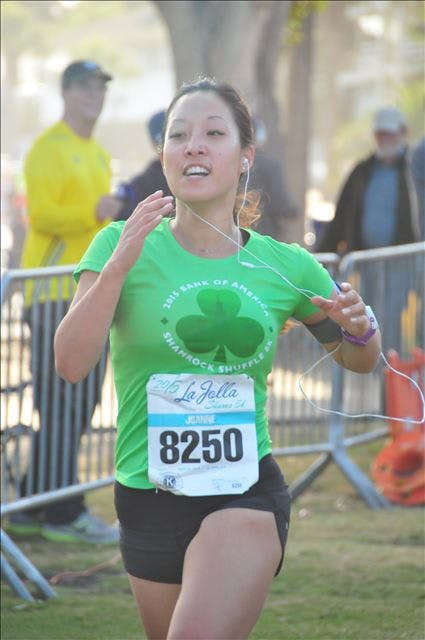
A friend of mine once told me,
“Confidence is a hard-earned thing.”
I didn’t understand exactly what she meant and didn’t have time to ask her to elaborate, but for some reason, the statement always stuck with me.
“Confidence is a hard-earned thing.”
Confidence is defined as “a feeling of self-assurance arising from one’s appreciation of one’s own abilities or qualities.” Thus, the opposite of confidence would be the lack of self-assurance, presumably arising from the same evaluation of one’s own abilities or qualities (or lack thereof).
Can you think of a time in your life when you wish you had more confidence?
I always think of my fear of cocktail parties or “networking” hours–those vile, structureless things that require you to “mingle” with people you don’t know; or, the last time someone (i.e., my husband) asked me to “dance” (which is honestly one of my worst nightmares). And of course, the torture that was the first three years of being a lawyer, when I felt like the most incompetent person on the planet, barely one step ahead of certain malpractice. The “imposter syndrome” that enshrouded my entire 17 year career as an attorney, that always had me wondering “when’s the penny going to drop so that everyone realizes I’m actually a shitty lawyer?” was also a symptom of a lack of confidence.
In these cases, it’s often not the lack of “one’s appreciation of one’s own abilities or qualities,” but a “mis-appreciation” of those things that results in a distorted sense of self. In fact, if you’re anything like me, you’re obsessively analyzing your “abilities and qualities” over and over again, hoping that this time, you’ll be able to say, “yeah, I’m the shit,” but instead, coming to the same, depressing conclusion that prevents you from being the “belle of the ball” or taking hold of your “Perry Mason Moment.”
Sometimes, though, a failure in confidence can cause far more harm than keeping you off the dance floor.
- It can prevent you from going after a promotion at work or leaving for a better job altogether.
- It can keep you from meeting new people, those who might inject laughter and love into your life.
- It can keep you stuck in unhealthy relationships, even when you know they’re bad for you.
- It can trick you into depending on substances (like drugs, alcohol, or even toxic foods) as a substitute for real joy.
Accordingly, it’s no wonder that one of the more frequent questions I get asked is, “How can I have more confidence?” This was a big question of my own for many years. And of all the things I could have tried to help me earn that elusive self-assurance, running, an activity I hated more than a dental appointment, was the last thing on my list.
That Time I Fainted In Junior High Because We Had To Run In Gym.
Growing up, other than the occasional game of tag, I had almost no willing interaction with running — either as a spectator or a participant. By the time I was in 6th grade, I hated running so much that the mere idea of jogging for any extended period of time caused full blown panic attacks. One year, when I was 12 years old, I was literally carted off by a team of paramedics because I passed out cold in 4th period woodshop class when I learned we would be running for a whole 20 minutes during gym class later that day. I was, from that point on, “the girl who fainted in woodshop” — which was totally ok with me if it meant I didn’t have to run for 20 minutes. (To my deep disappointment, we ended up having to do the same thing again in gym class two days later, and that time, I didn’t faint…).
So, it was with not-a-little-resentful disbelief that I would listen to people carry on about how much they “loved” running. Such people were either (a) lying, or (b) bat-shit. How could any rational human being voluntarily subject their bodies to bone damage, muscle cramps, heart palpitations, blisters, and the mind-numbing boredom that attended the most repetitive activity that God ever created? It would be one thing to run for some purpose — like because something was chasing you — but to do so “for fun”? Yeah, no.
Life has a strange way, though, of shifting one’s loyalties (or dis-loyalties). More than two decades after that 20-minute run around the track of Wilmette Junior High, I would find myself huffing and puffing towards the lighthouse at the end of the pier on North Avenue Beach in Chicago. Recently divorced, I moved into a small apartment in the city, right next to Lake Michigan. I’d gained about 40 pounds during the divorce, and figured I really had no excuse, since I now lived a stone’s throw away from 18 miles of uninterrupted running path along one of the most pristine bodies of water in the world. Plus, running is cheap: no gym membership, no expensive equipment. All I needed was a pair of sneakers. I didn’t even need a watch. I wasn’t timing myself and didn’t have any particular distance in mind. The only metrics I cared about were (a) how tired I was, and (b) my pride.
In 2013, my first “run” consisted of .75 miles along the lakefront path (I subsequently mapped it out on my phone). And I was so out of breath, I had to stop and rest for a few minutes at the turnaround point. But I came back to my apartment, got into the elevator, cheeks flush, heart still thumping, and I was proud of myself. Proud of myself for doing something I hated for my health. I stuck to it, running a few times a week to that same turnaround point. And eventually, .75 miles turned into a full mile. Then 2, 3, and even 4.

I Started Dating A Running Family.
It was around this time–when a 4-mile run was turning into my “weekly long run”–that I met Anthony. I “met” Anthony through OkCupid, a popular online dating website. There were two things that jumped out to me on his OKC profile: (a) the fact that he played classical piano, and (b) the picture of him running shirtless in a half-marathon. I would soon discover that he was an avid runner and that he came from a family of more-than-avid runners.
I met Anthony’s parents for the first time in October 2014 after the Chicago Marathon. Anthony and his brother, David, had just completed the big race and we headed over to a popular South Loop pizza joint, Flo & Santos, to celebrate. We pushed 3 tables together to accommodate family and friends, including Anthony’s cousin, Laura, who also ran the marathon (if I recall correctly, it was her 9th marathon). Despite being terrifically nervous about meeting Anthony’s family for the first time, Laura set me instantly at ease by telling me funny stories about running with her dad. If you’re a runner, you may have heard of him: Hal Higdon.
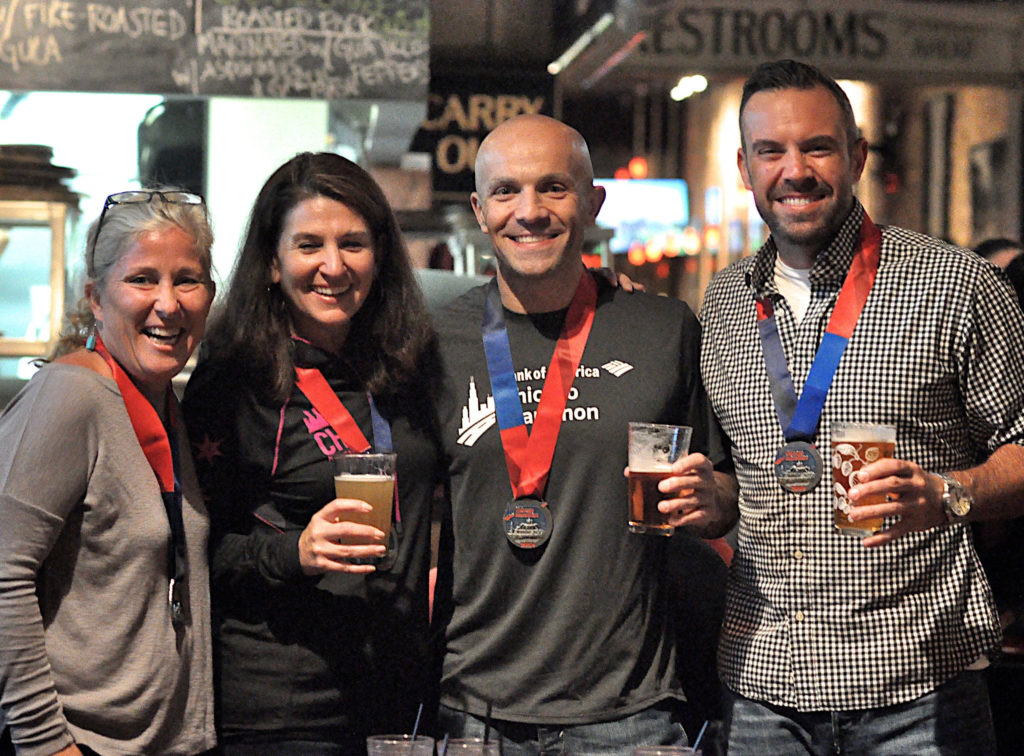
A few minutes later, though, the old heart rate got thumping again when Anthony’s father, Robert, and mother, Judy, walked through the glass door. I remember a handful of things from that first meeting with Anthony’s parents. First, how kind Judy was to me, as if she could actually hear my heart racing and was doing everything in her power to soothe me, in a way I was so unused to with just about every other person I’d known (including her own son!). Judy sat next to me and expertly guided our conversation with well-timed questions–all of which were easy to answer and designed to get me talking, to guard against awkward silences.
Second, Robert’s eyes–shaped just like Anthony’s. Kind, but penetrating. He didn’t speak with me very much, except when I asked him about running. I learned that Anthony’s father was also a longtime runner; he’d been crossing the finish lines of marathons since his early 30s. Though always athletic (he was both a tennis and soccer player), it wasn’t until he immigrated to the United States from Rome that he added running to his repertoire. It wasn’t surprising, then, that his boys — particularly his older son— followed in his footsteps (literally). He would teach his sons all about picking up their feet, wrestling with the wind, training through Chicago winters.
I guess it was only a matter of time before my runs along the lakefront would lead me to a race.
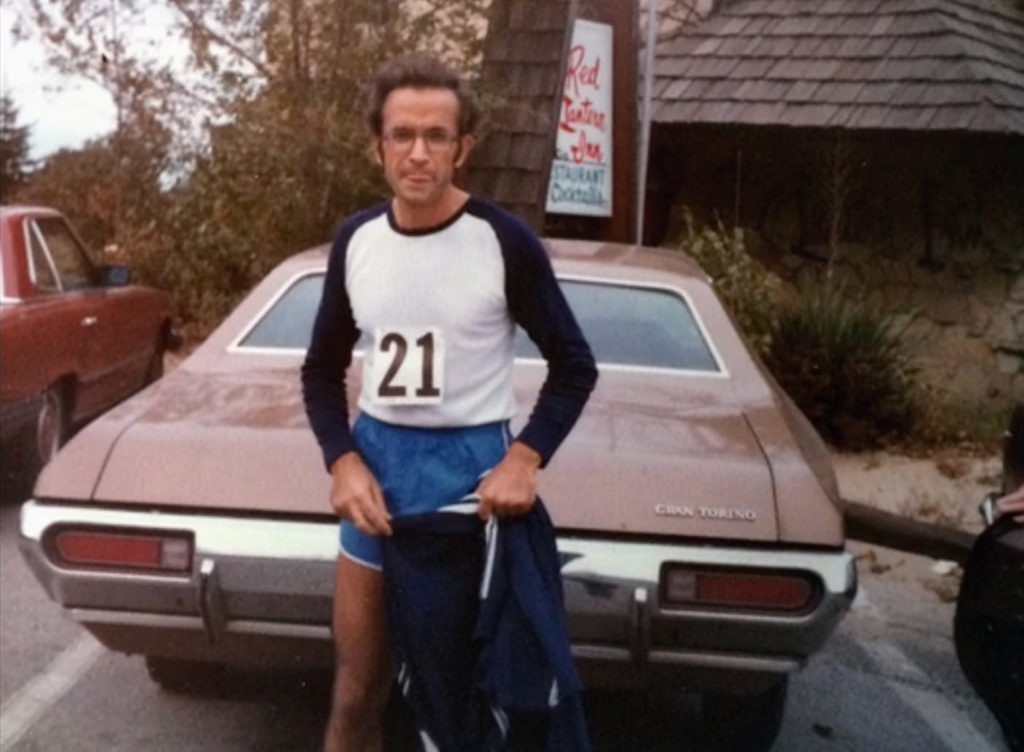
My Very First Marathon.
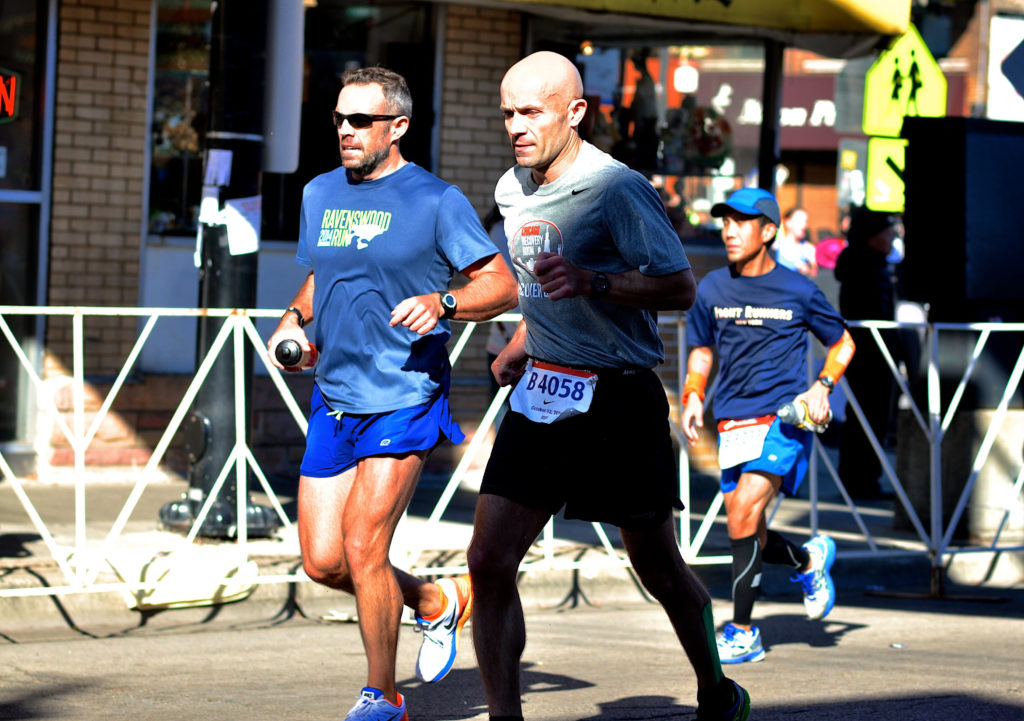
I like to say that my very first marathon was the one that Anthony and his brother David ran back in 2014. While I didn’t run it myself, I showed up and handed water bottles to Anthony at pre-planned locations along the winding 26.2-mile course. I’d never been to a marathon before, and seeing 40,000 people line up to engage in this collective session of self-inflicted torture was, indeed, a sight to behold. Although 80% of me was still of the “these people are crazy!” mentality, there was a not insubstantial part of me that was… intrigued. One of the most amazing things you’ll see at virtually any marathon is the number of participants who look nothing like what you see in your head when you hear the word “runner.”

Not everyone running a marathon is going to have long, muscular legs sprouting out of lean, sinewy frames (i.e., like my husband). In fact, after snapping photos of the wheelchair racers zipping down Wells, I was astonished to see numerous amputees on the course, not just keeping up, but pushing the pace on their prosthetics. Not everyone is going to be loping through the streets at a 7-minute mile pace. There were hundreds of “runners” who stopped to walked as early as mile 3 (which was my first “handoff spot” for Anthony’s water). You also don’t need to be rich to run a marathon. Training entails a pair of running shoes and a stopwatch (my law firm partner, Geoff, has been running marathons for decades and has never upgraded from his old school $5 stopwatch without GPS). While registration fees for some of the world marathon majors (e.g., Chicago, NYC, Boston, London, Berlin, Tokyo) can get pricey and might require travel, you can often find local marathons for less than $50. Accordingly, the race-pool was populated with athletes of all different levels of fitness, ability, and experience.
In short, witnessing the sheer diversity of runners at that very first marathon made me think that becoming one of them wasn’t such an impossibility after all.
I ran my very first race–a Turkey Trot (5k)–just a few weeks later. And it was like getting a tattoo–I was instantly addicted. I signed up for the Shamrock Shuffle a few months later, then the Soldier Field 10-miler, and before I knew it, a half-marathon. I liked racing. You not only got a really cool medal at the end, there was something about getting home after crossing the finish line–particularly if Anthony ran the same race–knowing that you’d just done something hard, painful, and entirely voluntary. I’d never done anything quite like it (the 20 minute runs in gym class were compulsory), and that feeling was exhilarating.
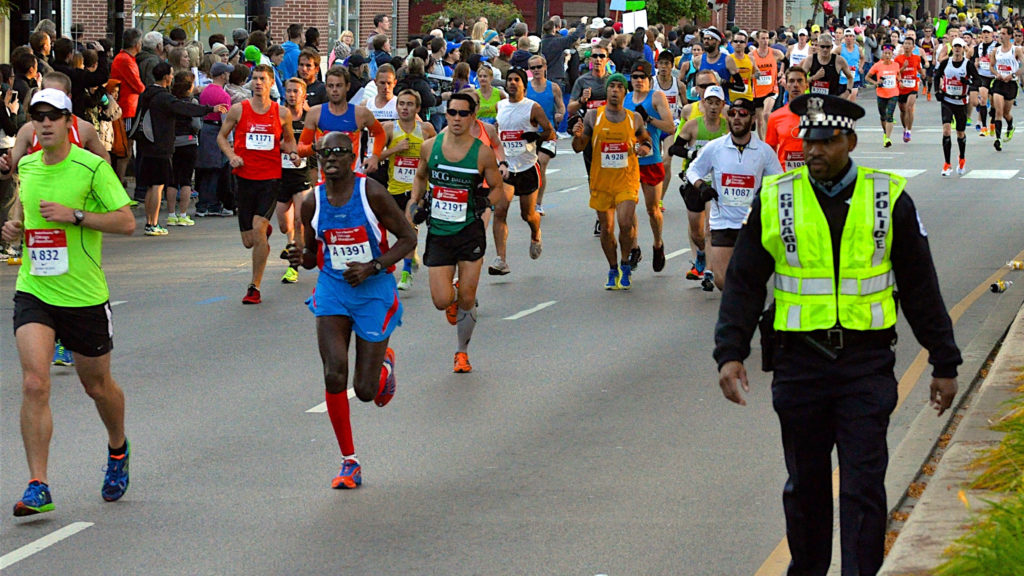
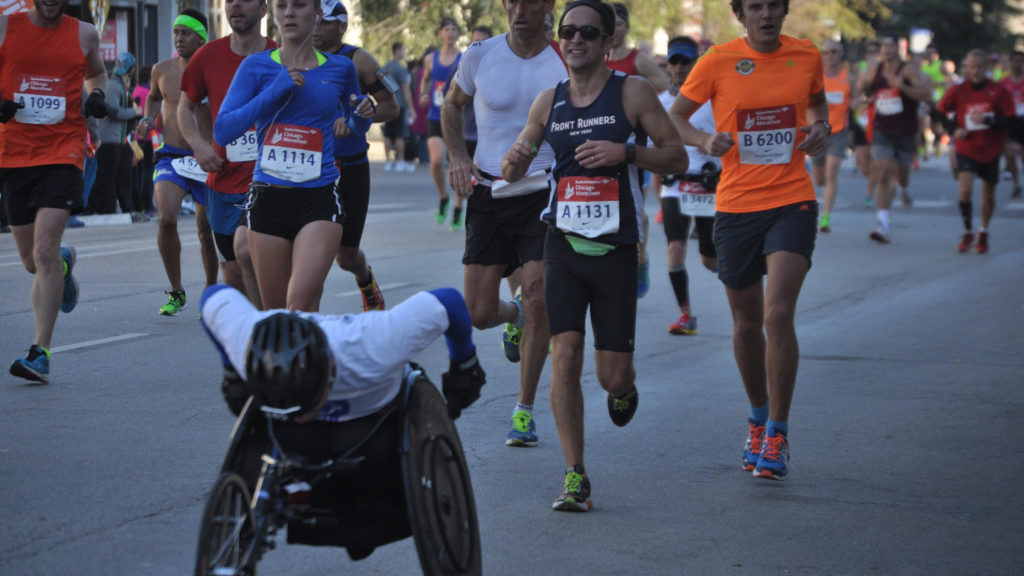
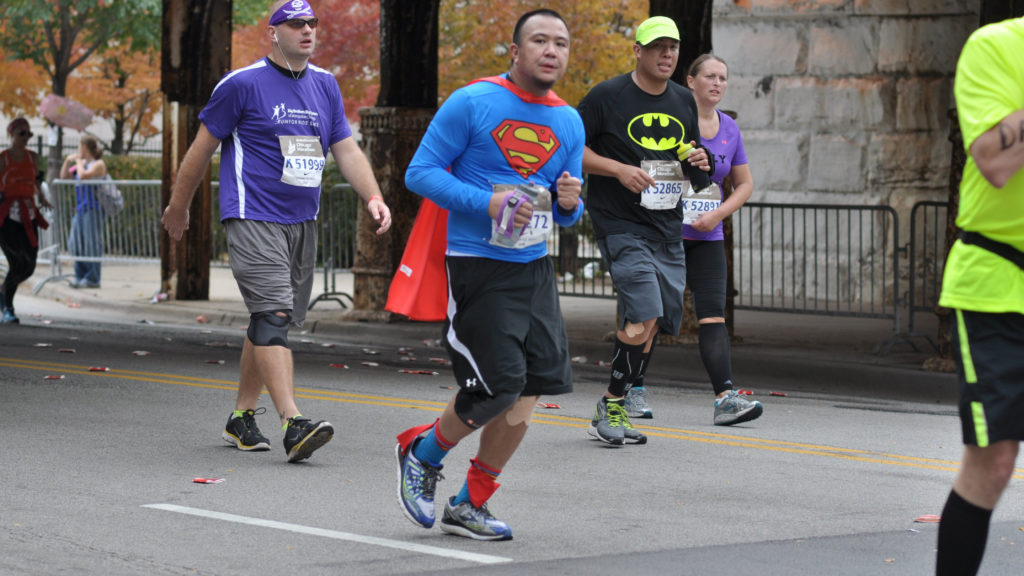
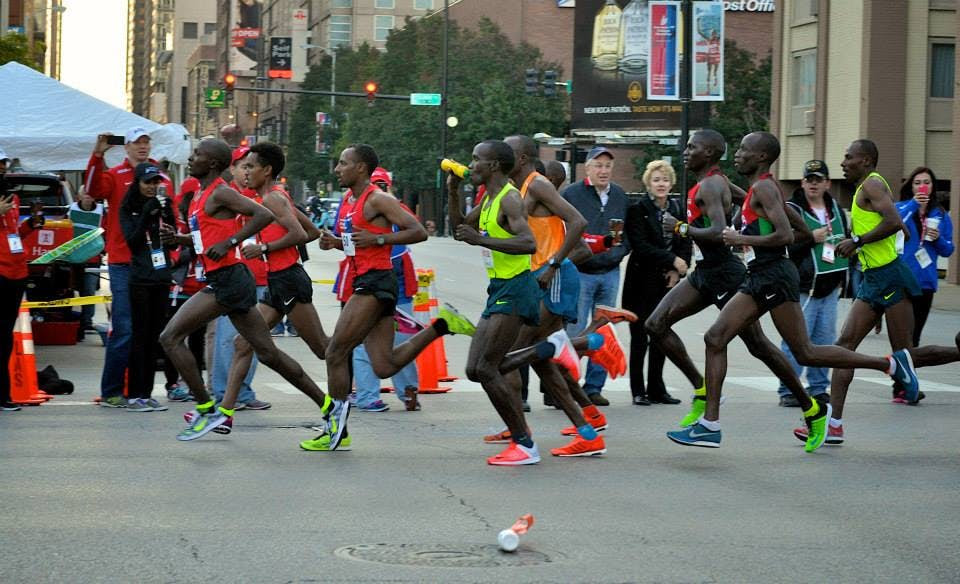
Before we get to my first time running a marathon, I don’t want to gloss over the evolution of my fitness. I cannot emphasize enough just how hard it was for me to complete that very first “run” along the lakefront path–the .75 miles that had to be broken up into two parts. That “inaugural” run took place in 2013. By the summer of 2014, I was running maybe 10 miles a week. By the time I assumed my role as “water girl[friend]” at the 2014 Chicago Marathon, the longest distance I’d ever run was 7 miles. I can still remember just how proud I was after completing my first 9.63 mile run, just a few weeks after Anthony ran 26.2. I wanted to run from my apartment all the way to one of my favorite cafes in Hyde Park, Medici’s, where my law school BFF used to pick up croissant sandwiches for our study group. Anthony met me there and took a picture of me with my latte, my face still flush with that hallmark post-run glow, and posted it on Facebook, telling me, authoritatively, that it was totally ok to round up and say I’d run 10 miles.
The Break-up That Caused A Growth-Spurt In My Running.
At some point, I realized that running wasn’t just a tool to help me lose some weight or stay in shape. It definitely brought me and Anthony closer. We shopped for my first pair of running shoes together. We went to pick up the racing bib for my very first race together and made out on the escalator on the way back. When I ran my first 6-mile run, he said, “Babe, that’s a real run. You’re a ‘serious runner’ when you’re regularly running 6 milers.” A comment he likely can’t remember, but one that burrowed into the deepest parts of me. In December 2014, we broke up for a month (I’ll save that story for another newsletter). It was horrible and depressing and not a little traumatizing (having been in only 2 relationships prior to Anthony, I’d never been dumped before). Let’s just say my running experienced a bit of a growth spurt during that month, partly because I was depressed and didn’t know what else to do to take my mind off of him, but mostly (I’ll be honest) to get his attention. I was posting all my runs on Facebook and I knew he’d be impressed if I kept up running even after he [sort of] exited my romantic life.
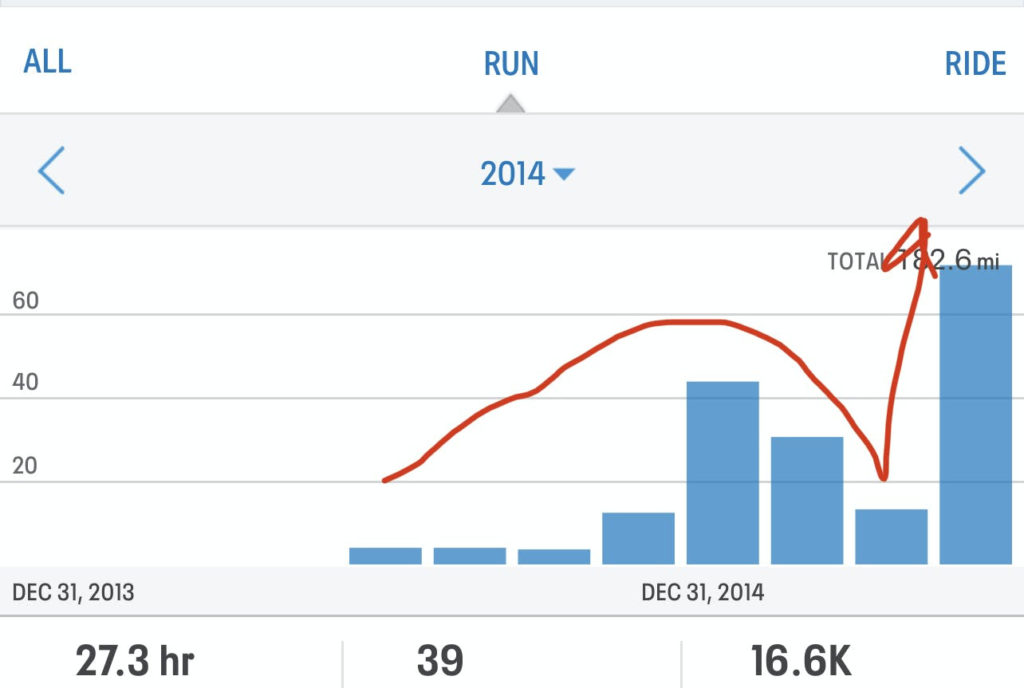
Sure enough, the day I posted that I’d run an actual 10 miles (not rounded up), he texted me immediately: “You’re INCREDIBLE!”
Do you have any idea what that does to a girl? To hear “You’re INCREDIBLE” from the guy who just dumped you a few days ago, even though you literally begged him to stick around? It’s a strange feeling, but not a bad one. And it motivated me to run more, run longer–well, at least as far and long as my body could reasonably undertake when it was subsisting exclusively on wine and chocolate truffles (it was a bad time).
Long story short (again, another newsletter), we got back together in January 2015. I made partner a few days after we got back together. He gifted me with a Garmin.
Hal Trains Me For My First Half Marathon (Sort Of).
Anthony wasn’t my only pseudo running coach. Anthony’s father, Robert, loved to talk running with anyone, including his son’s girlfriend. I will never ever forget the sight of 6 JUMBO sized blueberry muffins sitting on a cooling rack on Robert’s kitchen counter when I came back from the Shamrock Shuffle (the finish line was very close to Anthony’s parent’s condo in the city). He’d baked them for the “runners” (me, Anthony, and David) and, to this day, I think those muffins had a lot to do with my subsequent fascination with cooking and baking (which, as you no doubt know, totally changed my whole life). After growing seriously ill in 2008 with a host of autoimmune issues, Robert could no longer run himself, but he was enough of a runner to know just how life affirming a rack of blueberry muffins would be after running an all-out 8k.

I am an unapologetic people pleaser. I derive serious amounts of serotonin when adults are pleased with me. I was thus more determined than ever to get Anthony’s parents to fall in love with me. As soon as we went to his parents’ house (which was almost daily), I went straight to the living room couch, where Robert often liked to sit while propping his leg up (for better circulation). Robert loved to talk about three things: (a) running, (b) Rome, and (c) cooking. It is thus not surprising, I guess, that I am now a long distance runner who’s traveled to Rome 5 times (even got married there), and has a career in food.
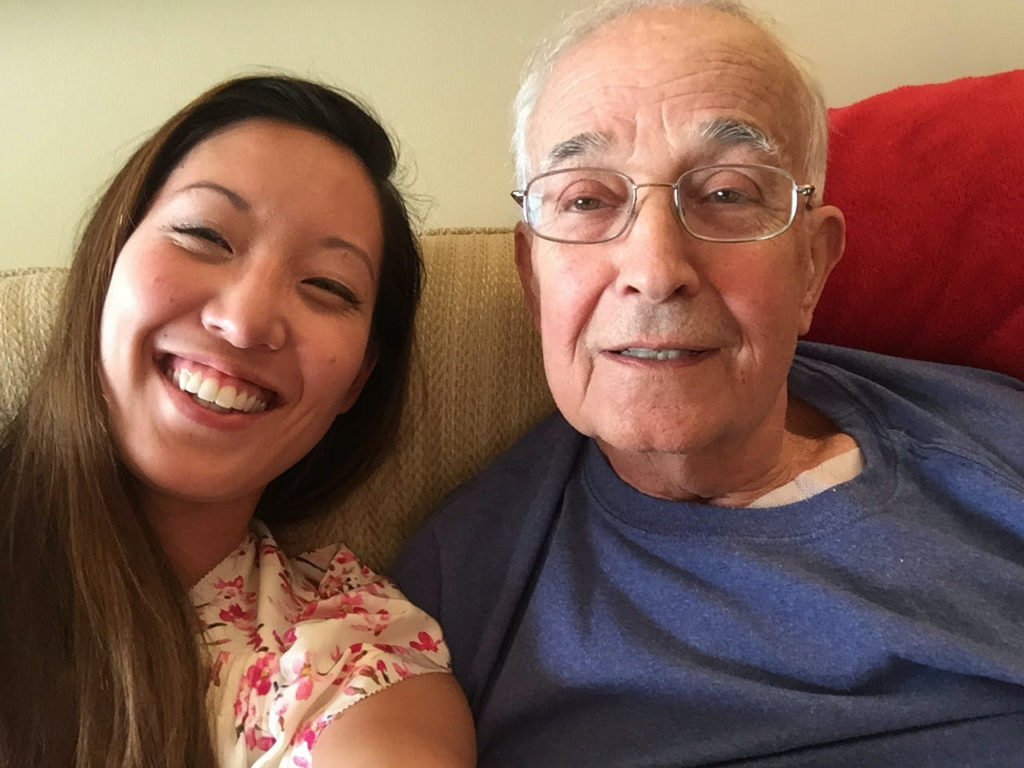
Unfortunately, Robert passed away in late 2015, so he never lived to see just how much influence our couch-chats had on my future. Specifically, shortly after he died, I quietly (silently) decided that one day, I would run a marathon. But first, I’d have to run a half-marathon, to make sure I didn’t die in the attempt (like the first dude to run a marathon). I thus registered for the Naperville Half Marathon, scheduled to take place in the fall of 2016. I downloaded Hal Higdon’s “Half Marathon for Novices” training app because, you know, he was basically family. I liked his app. He had a section in the training materials where he doled out non-running tips like “smile at the people on the course, it’ll make running more fun,” or “don’t overdo it on strength training because it can get in the way of your running,” or “running in the rain sucks” (I’m paraphrasing).
My entire family came out to see me run the half. The race went smoothly (thanks to Hal’s training!), with the exception of that moment at mile 10 when my right glute went numb and I had to walk for a bit. I ran right into my mother’s arms at the finish and as she held me, all I could think was:
“I’m going to run a fucking marathon!!”
The 2017 Chicago Marathon.
As I did with the half marathon, I downloaded Hal’s “Marathon for Novices” and stuck to it pretty assiduously for the entire 18-week training program. That’s right–in case you’ve never run a marathon before, the training generally takes 18 weeks (if you’re a beginner). The first “long run” is 6 miles. Your last long run is 20 miles, by which time 6 miles is often your “short run.” The training program is designed to condition your legs, glutes, back, arms, and shoulders to endure all 26.2 miles of the race. Very few people on earth can just roll out of bed and run a full marathon. Therefore, you meet your body where it’s at, trusting that the process of consistent time on your feet will eventually enable your body to do what it most certainly could not just a few months before. It is always so fascinating how my brain totally blanches at the thought of running 6 whole miles at the beginning of a training program and then sighs in total relief months later that “all I have to run is 6 miles.”

Some people think they can just skip the training program and run a whole marathon. Apparently, one of Anthony’s cousins, a very fit young man in his 20s, largely skipped most of the training but toed the line of the marathon anyway. He started out at a relatively brisk 10-minute mile pace, thinking he’d cruise his way to a 4-hour finish. Now he was fit, so he did finish, but he ended up walking most of it after mile 18. I, on the other hand, dutifully followed Hal’s training schedule, and was thus able to run the whole 26.2 miles, finishing way ahead of Anthony’s [much younger] cousin.
Yes, I did finish that marathon. And it was hard and scary and intimidating and painful (especially after mile 18). But it was also fun and exciting and extraordinary and emotional. If you’ve read my book, then you’ll know that the absolute most memorable thing about that race wasn’t crossing the finish line after turning the corner onto Columbus or running with Anthony through Chinatown or the happy mariachi band in Pilsen. It was right at around mile 20, when I saw my father.
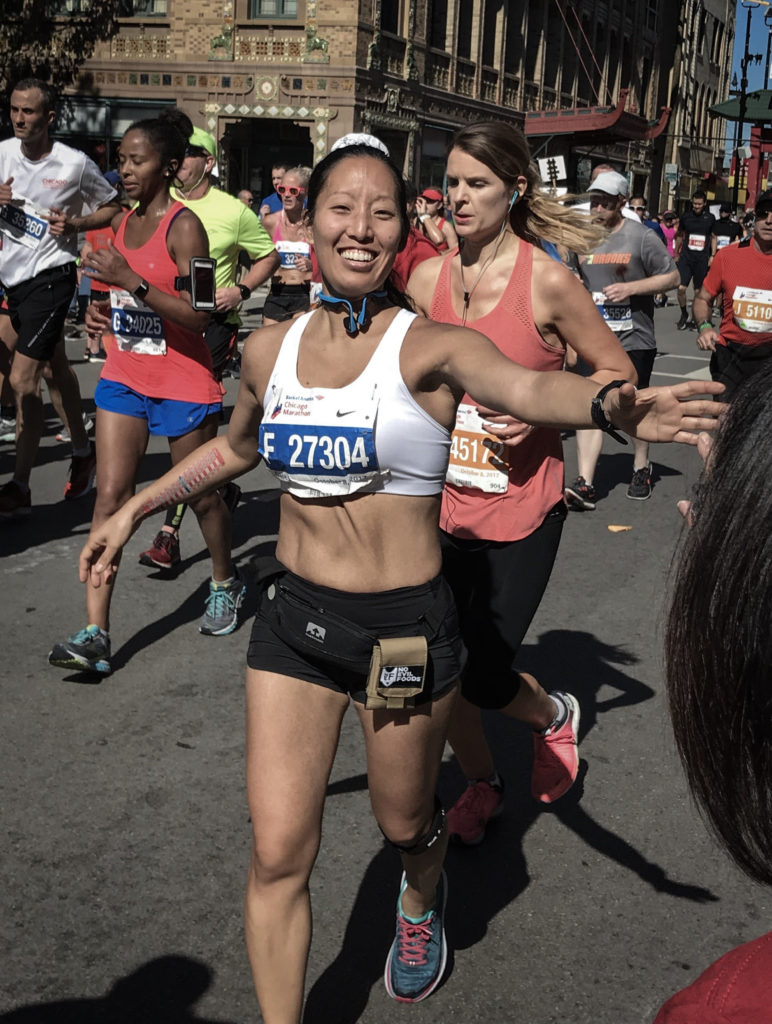
My father was so excited to watch me run the marathon, which I thought was odd, given that he’d never been really excited to see me do anything (he generally tends to fall asleep at things like recitals, graduations, even when I got sworn into the bar). And because my mother was in Korea and thus unable to chaperone him, I was a little reluctant to have him there. I remember telling him, “Daddy, you don’t need to come, like, it’s going to be really boring. And cold!” (The marathon is in October.) But he bowled right over me, “Oh sure sure, I be there! How long you think you take?” Omma assured me he would be all right. She’d arranged to have him join a local Korean community group that was taking a bus down to the city and setting up a cheering station on 18th street, just before the 20 mile marker. The bus picked my dad up at 6 in the morning. He parked himself on a lawn chair at around 6:45 am, when it was in the mid-50s. He was going to see his daughter run a marathon.
I hadn’t even gotten to the start line yet.
I didn’t start running until 8:17 am, more than an hour and a half after my dad started waiting for me. It would be nearly 4 hours before I finally got to that point on the course. By that time, Anthony had prepped him and Daddy was standing with a bottle of water in his hands, craning his head, looking for my face among a sea of sweaty faces. And when he finally saw me, his face nearly split in half from his smile. He started running with me, my 72 year old dad with a bottle water in his hands, shouting, “Joanne!! Should I run with you? Can I run with you??”
Needless to say, I was practically sobbing as I turned the corner onto Halsted, my father still cheering behind me.
My father literally jumped up and down when I passed the bar exam. He slapped me on the back when I got a full time job at the Firm. And he raised a glass and congratulated me when I finally got a divorce. But I honestly don’t think I’ve ever seen my father more proud of me than on the day he waited nearly six hours to hand me a bottle of water at mile 20 of the Chicago Marathon.
Running Marathons Will Change Your Brain. Literally.
Marathon training doesn’t just change your physical body. It changes your brain. And I’m not just talking about touchy-feely guru stuff. A recent study found that marathon training improves neuroplasticity, i.e., the neurons’ ability “to compensate for injury and disease and to adjust their activities in response to new situations or to changes in their environment.” One 2018 study suggests that 30 minutes of running can even help to fight off anxiety and depression. You hear fitness influencers talk about mental toughness all the time. One of my favorites, Sage Canaday–whom I watched on YouTube obsessively in preparation for my first marathon, has entire videos on just the mental aspects of running a marathon. The brain is a muscle, and therefore, if you challenge it enough (but not too much), it’ll get stronger, just like every other muscle in your body.
There are really three things that require mental toughness when you’re running long distance:
- Overcoming the brain’s disbelief that you can complete the assigned task (whether it’s to run 6 miles or 26 miles), especially if you’ve never done it before. This disbelief is reinforced by your body’s inherent inertia, that part of you that would rather sit on the couch and binge watch The Bear while eating Pringles.
- The sheer boredom of running, especially if you’re on a treadmill or running by yourself. Depending on the pace you train at (which will almost always be significantly slower than you think), you’ll be out there anywhere from 1 to 4 hours. That’s a very long time to be doing the same exact activity without interruption.
- Coping with the pain, and by pain, I do mean physical discomfort. Some long runs will be pain free and easy (especially if you’re already really fit and run a lot). But there will always be a long run (or 18 of them) that causes pain in your feet, toes, knees, ankles, shoulders, back, etc. And on the day of the marathon, if you’re pushing yourself to the limit, at some point, you will hurt.
How Running Changed My Brain.
What’s the first thing you do right after crossing the finish line of a marathon? Stuff your face with free potato chips (the sodium + carbs). Ok, the second thing? You decide on your next marathon. While sauntering back towards Anthony’s parents’ house (again, the finish line was a few blocks from their condo), I decided to register for the Flying Pig Marathon in May 2018. Upon completing that one, I signed up again for the Chicago Marathon in October 2018.

2018 was a busy year for me. I was chief litigation counsel in a massive Ponzi scheme case and I was planning my wedding, which was set for July in Rome. It was maybe not the best year to attempt back-to-back marathons. I had about a 3 week break between sprinting across the finish line of the Flying Pig to starting all over again with a new bloc of training for Chicago, while also preparing for my wedding in Italy. Still, I enjoyed the regimented nature of marathon training. Five times a week, I started the day with a run, making those two “off days” all the more precious. Although sacrificing my weekends for long runs and recovery could grow taxing, the slow build over 18-week training blocs allowed running to slip into my daily routine, until it became as much a part of my life as brushing my teeth or doing my time entries.
Thus, even though most normal people take a short hiatus from training on their wedding day and honeymoon, I did not. I ran 12.87 km (~8 miles) on a rickety old treadmill in the “gym” of our hotel on the morning of our wedding. During our honeymoon, I was determined to complete all of the training runs my coach scheduled for me throughout the craggy hills of Sardegna, the cobbled streets of Turin, and on that slightly scary hotel treadmill, if necessary. But, after nearly falling to my death while running up and down the hills of Sardegna on Day 2 of our honeymoon, I had a heart-to-heart with my coach and determined that we’d defer Chicago and sign up for Indy Monumental, which took place a month later (in November). This would give me a little breathing space while Anthony and I enjoyed the remainder of our trip.

The wedding and honeymoon were a dream in many ways. Anthony and I (mostly I) planned the perfect wedding. A small group of only 35 or so guests, consisting of family and our close friends. We held our ceremony in a deconsecrated church in Rome (because I was a divorcee, we could not get married in a church) and our wedding reception on the rooftop of the Minerva Hotel. Our dinner menu was entirely vegan, right down to the chantilly cream wedding cake (which was the best wedding cake I’ve ever had in my life). After a couple more days in Rome, we set out for the crystal blue shores of Sardegna, followed by a fun few days in Turin (touted as the vegetarian capital of Europe), and then returned to Rome to finish off our honeymoon along the sultry streets of Trastevere.
There was, however, a small blemish on our nuptials.
My ex-husband.
Believe it or not, I had to entertain multiple phone calls from my ex while on my freaking honeymoon. And, as you might guess, it was the opposite of fun or romantic. As part of our divorce settlement, my ex got to keep the house. But a few weeks after my alimony payments started to shrink (in accordance with the graduated payment schedule in our agreement), he could no longer afford the mortgage. And guess what? My name–and only my name–was on the mortgage. He was required to transfer the mortgage into his name only, but, of course, failed to do so. Selling the house would be nearly impossible–we bought it in 2007, just before the market crashed.
Having to deal with this nightmare while training for marathons, working around the clock, and preparing for a wedding was grating. Having to tell my new husband, “sorry, babe, I have to take this call from your predecessor” while checking out all the cute little cafes in Sardegna was unbearable. The saga continued even after we got back to Chicago. I had to hire my own lawyer, have multiple tense conversations with my ex-husband, pour money down the drain to shore up his finances and my credit. I remember hanging up the phone after yet another heated call with my ex one afternoon in my bedroom, my body bending to some invisible weight across my shoulders, bringing my fists up to the sides of my head as if I could somehow lobotomize myself, completely erase that part of my brain that had any memory of my first marriage and its aftermath. In so many ways, it was like being thrown into the pit of my divorce all over again, something I’d worked so hard to climb out of the first time, only to have him waiting for me when I got out.
I crumbled into my bed, started sobbing into the comforter. I didn’t see a way out. Despite moving out, getting remarried, and finally finding some measure of healing, it seemed I would be stuck paying for the biggest mistake of my life forever. The words, “I can’t do this I can’t do this I can’t do this” circled my head like a carousel, as I toed the edge of my despair. Then, somewhere, a guttural but still familiar voice, filled the room:
“You’ve run a fucking marathon. You got this.”
I was surprised to discover that this voice?
It was my own.
Ask Joanne (Sort of).
Normally, I use this space to answer questions that have been submitted by newsletter readers/podcast listeners. But this week, I thought it might be interesting to answer some questions you might have on something I’ve personally found totally riveting: the Alex Jones trial.

For those of you who don’t know, Alex Jones is the creator of a website called “InfoWars,” funded by the company Free Speech Systems LLC. Among many conspiracy theories, InfoWars has propagated the notion that the Sandy Hook tragedy was a scam constructed by anti-gun lobbyists; that the murdered children and surviving parents are all paid actors. Jones’s more rabid fans began to stalk the Sandy Hook parents (who they believed to be actors, thanks to Jones), publishing their known whereabouts and addresses so they could be harassed with death threats for the rest of their lives. Not surprisingly, the Sandy Hook parents hired a lawyer and sued Jones and his company Free Speech (collectively, “Jones”) for, among other things, defamation. Last week, in Texas state court, the parties concluded their trial and the jury awarded two Sandy Hook parents $45 million in damages.
I’ve watched a lot of trials in my day and even putting to one side the total catharsis of watching karma do her thang with the likes of Alex Jones, some of the things that occurred during this trial were absolutely jaw dropping.
Here are a few highlights, along with a brief legal analysis of each:
- So, was Alex Jones already found guilty? All of the lawsuits filed against Alex Jones are civil proceedings and therefore, his “guilt” is not on trial. That said, he was already found liable for defamation. What’s interesting here is that his liability was not determined in typical fashion, by a jury trial. Instead, because he refused to make certain obligatory disclosures under the applicable rules of discovery, the judge entered default judgments against him. In other words, no jury ever said “yup he defamed plaintiffs.” Rather, it was Alex Jones’s own stubborn refusal to comply with court orders that permitted judges to enter a judgment of liability against him and his company without Jones ever presenting a defense. What we saw last week was only the damages portion of the trial, i.e., the phase typically after liability has been determined. Word to the wise: your ego is never ever EVER worth a default judgment.
- How many lawsuits are there? Sandy Hook parents filed lawsuits against Jones in three separate proceedings, pending in Texas and Connecticut. Default judgments were entered against Jones in all of them; however, only one made it to trial for damages, which is the one we saw last week. Why? Because Jones filed for protection under chapter 11 of the US Bankruptcy Code before the others could proceed. The Bankruptcy Code has this thing called an “automatic stay” which basically hits the “pause button” on any pending litigation against the debtor (in this case, Jones). However, the one that already made it to trial was permitted to proceed as an exception to the general rule. Plaintiffs in the other lawsuits, are, however, trying to obtain an exception for their lawsuits, as well.
- Liar, Liar, Pants on Fire? Jones was warned repeatedly by the Judge not to lie. But the ultimate pants-on-fire moment occurred on the last day of trial, when plaintiff’s counsel disclosed that Jones’s lawyer accidentally turned over all of Jones’s text messages in the past 2 years. Prior to trial, Jones repeatedly testified, under oath (during deposition), that he had no text messages related to Sandy Hook. t came as no surprise to basically EVERYONE that a review of Jones’s inadvertently produced text messages revealed many many MANY text messages about Sandy Hook. Jones, himself, called this the other side’s “Perry Mason” moment.
- Wait, wait, wait–“accidentally turned over”? Yes. According to a motion filed by Jones’s lawyer, their paralegal inadvertently sent the plaintiff’s counsel a number of files and folders that Jones never intended to produce. It appears that many of these documents (i.e., the text messages related to Sandy Hook) should have been produced anyway (but for the fact that Jones lied about having them). However, it also appears that there were probably a bunch of files that were either irrelevant or, more importantly, protected under the attorney-client privilege. Now, this happens a LOT MORE OFTEN than you probably realize. I mean, how many times has someone in your office hit the “reply all” when it was clearly meant to be a “reply” to one? Inadvertent productions happen about as frequently as that. Usually, in this situation, the side that made the production (by accident) will send an email to the other side saying, “Oops, my bad, can you just hit delete?” because the parties have an agreed Discovery Protocol Order that covers how to handle just these kinds of situations in advance. In this case, Plaintiff’s lawyer immediately alerted Jones’s lawyer, and Jones’s lawyer immediately responded with an email saying, “Please disregard.”
- So, how come Plaintiff’s lawyer didn’t hit delete? Because, here, the parties didn’t have a Discovery Protocol Order, and therefore, it defaulted to the existing state rules that apply in these situations. Under Texas law, when a party makes an inadvertent disclosure, it has to notify the other side and redo the entire production correctly. This means Jones was supposed to produce a privilege log–a spreadsheet that identifies everything Jones is not producing (even if it’s relevant to the lawsuit) because it’s covered under the privilege. A lot of times, in smaller cases, the parties dispense with producing privilege logs, because privilege disputes are annoying, expensive, and usually result in nothing. Here, however, Plaintiff’s lawyer already had access to the documents that were purportedly privileged and therefore, Jones’s lawyer would have had to produce a privilege log to claw them back. The rule requires him to do so within 10 days of the inadvertent disclosure. He didn’t. Probably because he was lazy and didn’t want to do a full-blown priv log and thought that Plaintiff’s lawyer would simply do him the courtesy of “disregarding.” Gambling on ordinary legal courtesies was idiotic in a case charged with Alex Jones level toxicity.
- Then does Alex Jones go to jail for perjury? Probably not. The judge had multiple opportunities to hold Jones in contempt during the trial and chose not to do so. Moreover, perjury prosecutions are exceedingly rare in Texas and, in this case, lying under oath in a deposition is not as egregious (it’s only a misdemeanor) as lying in court (which is a felony). A perjury case would require a trial on whether Jones knew his statement under oath was untrue (which would be hard and expensive to prove), and thus may not be worth it.
- Will the $49 million judgment against Jones stick? Probably not. Just to recap, in case you missed it: Plaintiffs asked for $150 million in their complaint against Jones. The jury awarded $4.1 million in “compensatory damages,” and $45 million in punitive damages. However, under Texas law, punitive damages can never exceed twice the amount of economic damages (i.e., the amount plaintiffs have to pay out of pocket due to defendant’s conduct), plus $750,000. So you’d think, then, it’s (2 x $4.1 million) + $750,000 + $4.1 million = $13.05 million–WAY less than $49.1 million. BUT, in this case, it’s still a little unclear whether the $4.1 million the jury awarded in compensatory damages can be fairly classified as “economic damages.” If, as many suspect, the jury awarded $4.1 million for pain and suffering (and not, for example, the amount of money plaintiffs expended to pay for therapy, relocate every time stalkers found them, etc.), then punitive damages would be twice the amount of $0 plus $750,000, leading to total damages in the amount of $4.85 million. Pretty much a slap on the wrist for a man worth over $150 million.
- Do Plaintiffs have any way of keeping the entire judgment? Probably not. The statute is not discretionary. It mandates the application of the cap. While some have argued that doing so would be unconstitutional, the Texas Supreme Court has indicated that it has no problem with the constitutionality of Texas’s statutory cap, calling it “automatic.” There is one interesting exception to the cap. Under Texas law, there is no cap on punitive damages when the case involves the fraudulent concealment of documents. “HUZZAH!! The text messages!!,” you might say. But no. The Texas Supreme Court has stated, albeit in dicta, that the exception to a statutory cap on damages needs to be pled–i.e., needs to be in the complaint. As far as I know, Plaintiffs did not plead an exception to the statutory cap, and therefore, they’re out of luck.
- But what about the other two trials? Well, recall, they are still stayed by virtue of the Jones bankruptcy. Assuming, however, the stay is lifted to allow them to proceed, one of them is in Texas and another is in Connecticut. Both states have rather limiting statutory caps. It’s possible that counsel for plaintiffs in those two cases will have learned a thing or two from the outcome of this most recent case, and will therefore be much more mindful on crafting a damage case and providing thoughtful jury instructions (though they can’t be explicit–the rules prevent parties from alerting juries to a cap before they head into deliberations).
- What happens now that Jones has filed for bankruptcy? In addition to a stay on any pending litigation (with specific bankruptcy court-sanctioned exceptions like the most recent trial), chapter 11 would require judgment creditors (like plaintiffs) to file a proof of claim in the bankruptcy case, meaning that plaintiffs would likely only receive a fraction of what would almost certainly be a reduced judgment to begin with. Worse yet? Jones would be able to start over, with a clean slate, as if nothing happened. HOWEVER, it is very possible that the bankruptcy case might end up getting dismissed (kinda like the one filed by the NRA) for a host of reasons, the biggest one being that Jones filed the bankruptcy petition in bad faith. Not only have there been numerous allegations that he siphoned funds from his company so that judgment creditors would be unable to have access to them (all of which will come out in bankruptcy court and then clawed back for the benefit of creditors), but he filed the case in the middle of trial. Moreover, given Jones’s track record for lying, I would not be surprised if the financial disclosures he’s required to make in bankruptcy (truly a nightmare for someone who was willing to take a default judgment rather than produce a much lighter version of those disclosures in the defamation cases) are filled with inaccuracies and redaction, all of which will land him in hot water with the US Trustee’s Office, which, btw, is an arm of the DOJ (which, btw, is very interested in Jones’s text messages and potential involvement with the January 6 riots).
All right! That wraps up this slightly random “Ask Joanne.” Next week, we will resume taking reader/listener questions, so hit the link below!

I’m giving away a copy of Plant-Based India. Enter below for your chance to win!
Updates/Random Things (Show Notes)
- GIVEAWAY ALERT: So, in case you missed it, one of Instagram’s most talented creators, Dr. Sheil Shukla, published a BEAUTIFUL new cookbook called Plant Based India. I was lucky enough to receive an early look at the book and I’m not joking when I say I want to cook every single recipe in this book!! For those of you who don’t know, Dr. Shukla is a board certified physician and brings both his medical knowledge and cultural cuisine to not only his kitchen, but also yours. I’m so excited about this book that I’m giving a copy of it away to one lucky reader/listener. Sign up above for your chance to win!
- What I’m Watching: Ok, I finally gave in and watched The Bear. And it was SO SO good. However, there are quite a few non-vegan scenes in this show, so just a heads up–there might be parts you need to cover your eyes for. Otherwise, the writing is excellent, the acting superb, and many of the recipes are eminently veganizable (look for it on a meal planner near you!). I highly recommend that you check it out. For Chicagoans–it is a love letter to your home.
- My Favorite KV Beauty Product: As I mentioned last week, my newfound hobby is watching for fun kitchen gadgets and beauty products on my favorite Korean dramas. This past week on The Extraordinary Attorney Woo, one of the characters bust out what looks like a really thick lip balm and–rubs it all over her face and neck!! Yup, Korea’s new “it” product is a FACE BALM! I found a vegan version here!
- New Recipe: Fruit, fruit, fruit! I’m stickin’ to a no-sugar added regiment these days and made the most delicious fruit salad ever. Here are my secrets to a kickin’ fruit salad: (a) a healthy squeeze of grapefruit juice for tartness, and (b) pinch of gochugaru for heat! Otherwise, I included peaches, strawberries, blueberries, blackberries, grapefruit, and grapes in my fruit salad. I made a bunch for some company the other day and it was all gone in a few minutes!
Parting Thoughts.

I still can’t believe it, even when I say it out loud, but I’ve been running, now, for 9 years. Keep in mind: I am the same girl who had a panic attack, fainted, and was carted off to the emergency room the first time I learned we would have to run for 20 minutes—IN A ROW—in gym class. And somehow, I’ve transformed into a person who can’t imagine life without it.
I’m not fast. My best marathon time is a 4:15:22 (Indy Monumental). But if anyone told me when I set out to run my 4 mile “long run” back in March 2014 that one day, I would cross the finish line of not one but five marathons, I would have replied, “Wait, how long is a marathon?” I knew nothing about running, other than what the human body is born knowing—you do it when something is chasing you.
Since then, as I continue to “chip away” towards my goals, I struggle with a lot self-doubt—particularly after a rather disappointing finish to my last marathon. I keep hearing, “You just don’t have a runner’s body,” and wonder whose voice that might be? Is it the voice of my nameless critics, who sneer at my Strava stats? Is it all the glossy magazines that feature women who look nothing like me, as their long and skinny legs glide past a blue and yellow finish line? Is it the voice of my teammates, the ones I call “the Varsity Squad,” who float past me with a gracious smile, their lean, lithe bodies arching effortlessly past my own huffing and puffing form? Is it the voice of my husband, who looks like he’s been carved out of marble even after downing 3 pints of Ben & Jerry’s and considers a 7:30 mile “slow”?
No. I know whose voice it is.
I’m not stupid. Some humans are better equipped to run fast, run long, or just run, just like some bodies are better at singing arias with an E over high C (I studied vocal performance for 5 years and managed that feat only a handful of times). But I have zero aspirations of becoming a professional runner, just as I no longer harbor any dreams of a career in singing.
My legs are very short, bowed, and top heavy. My ankles are weak and prone to rolling (especially when loose acorns are on the prowl). I have what some may call a “voluptuous” body (T&A). In my entire life, I have never been “thin” (that’s another story). I think of all the thousands of miles I’ve logged since my inaugural .75-mile long run in 2013. And despite the hundreds of thousands of times my foot has pounded on that pavement, the road has never once chastised me for being too heavy. The road has never criticized me for how my thighs graze with each step. The road has never laughed at how my legs pump instead of stride. The road has never given me side-eye for wearing the wrong running shorts or sports bra. The road has never judged me for the number of times I’ve been passed or stopped to walk. The road didn’t try to shame me when I finished my last marathon in nearly 6 hours. The road didn’t ignore me when I came back after taking a 6-month break to recover from injuries. The road didn’t all of a sudden pretended it didn’t know me when my “comfortable pace” went from 10 minute miles to 13 minute miles.
The road has never demanded I run slower, faster, or longer. The road has never questioned my motives, my determination, or my will.
I ran 10 miles this morning. Alone. I could hear the thudding of my footsteps, keeping apace with the thudding of my heart.
– Joanne
